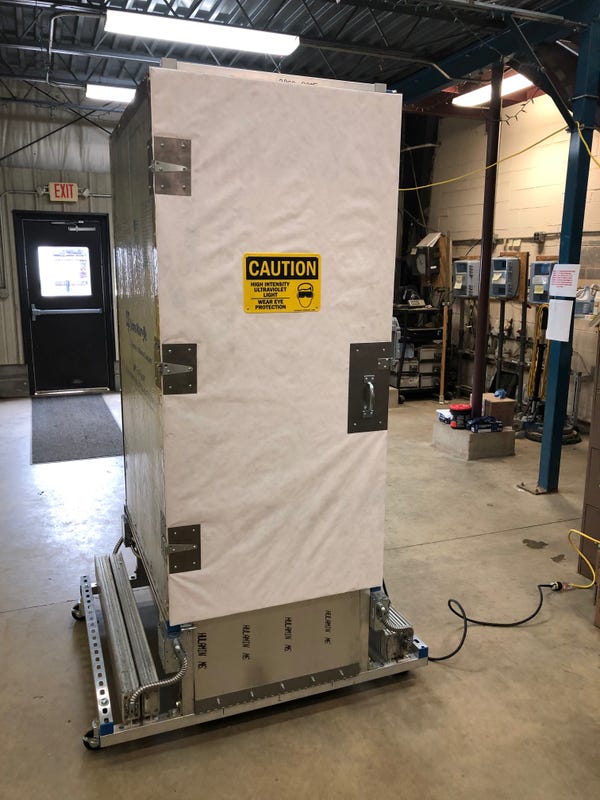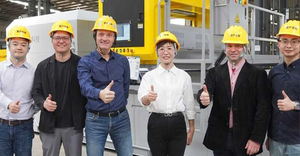
When Frederick, MD’s health system started seeing a rise in COVID-19 cases, their supplies of N-95 masks/respirators were getting very low, and there were concerns about the possibility of running out of this critical personal protective equipment. Local government stepped in to ensure lasting supplies—and brought Frederick County’s Division of Utilities and Solid Waste Management (DUSWM) into the picture.
Some local providers had been using ultraviolet light (UV) room sterilizers on used masks, hanging them in a room, closing the door and waiting until UV levels reached, and remained, at a level sufficient to sterilize the room and its contents, says Mark Schweitzer, division of Utilities and Solid Waste Management acting director.
“But this equipment was now needed for other uses; meanwhile we had experience with UV disinfection, which we use at our wastewater treatment plant to disinfect treated wastewater,” says Schweitzer. So the utility built a sterilization unit for its community’s health care workers.
They had UV tubes that generate the light, UV ballasts that power the system, and meters to measure UV intensity. And they had a maintenance department familiar with the UV technology who knew how to build the unit.

Frederick County’s deputy chief administrative officer, who
formerly held Schweitzer’s job at DUSWM, was heavily involved in building and proving out the technology, relying on Centers for Disease Control guidance materials during design and construction.
The sterilization system consists of a small enclosed cabinet, resembling a toaster, with racks and UV lights inside. Wheels roll the racks that the masks hang on, eradiating them within about 20 minutes.
They had a target dose rate of 1 Jewell per square centimeter, which is the dose of UV light needed to disinfect a mask. And there was some work to be done to validate they were reaching that mark.
“We had experience validating batches from our autoclave process
whereby we put tape on a test tube, and once it gets to a certain temperature stripes appear on the tape. We hoped to apply similar principals using color strips to confirm we got to the required UV dose,” says Schweitzer.
His division collaborated with the University of California, Berkeley, who was researching UV light-sensitive test strips and was specifically studying color measurement. But commercial color strips did not prove accurate, so DUSWM staff ended up simply using conservative time estimates to determine they were reaching the right UV dose.
Where the University of Berkeley came in especially helpful was in informing how to interpret and calculate intensity and dose.
“And we learned from them that Tyvek is highly reflective of UV light, so we ended up lining the inside of the chamber with Tyvek house wrap. It increased the overall intensity of light to get to the required 1 Jewell dose much faster,” says Schweitzer. (See here)
Michael Marschner, deputy chief administrative officer for
Frederick County, was the one who asked DUSWM to put together a UV-C test unit to verify spare parts from the division’s UV-C disinfection system could be used to decontaminate N-95 masks.
“That initial unit was really a proof-of-concept. Once we were able to verify that the system could achieve the necessary energy levels for inactivation of Corona virus analogs, I provided staff with diagrams for the first operational prototype. This included the removable racks that allow increased throughput, significantly increasing the number of masks that could be treated each day,” says Marschner.
A severe shortage of the N-95 masks could have greatly increased the risk to health care providers, possibly rendering them incapacitated, he noted.
“Nurses, doctors, and other medical staff may be forced to wear soiled or contaminated masks, increasing their exposure risk. No one knew if there would be enough N-95 masks if the hospital was overwhelmed with COVID-19 patients. We acted on this idea, building an operational unit within four weeks, preparing for the worst case but hoping for the best case—that the decontamination unit would not be needed,” says Marschner.

Supply concerns have subsided since DUSWM went to work on this project, but the first fully fine-tuned unit remains at the hospital for emergency use. A second unit is ready as a back should it be needed.
And since UV light breaks down the genetic material of other viruses and bacteria, preventing them from replicating, this technology could be used, not only should there be a spike in COVID-19 cases, but it could sterilize supplies and equipment with other illnesses.
About the Author(s)
You May Also Like




